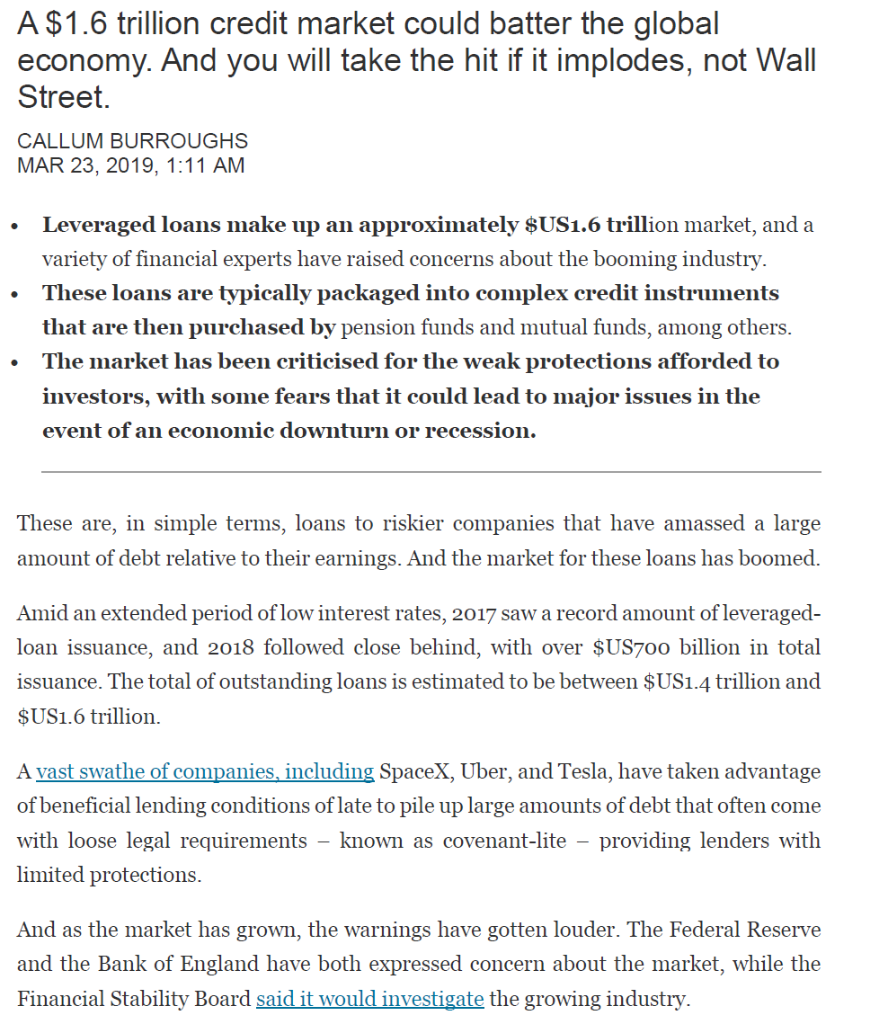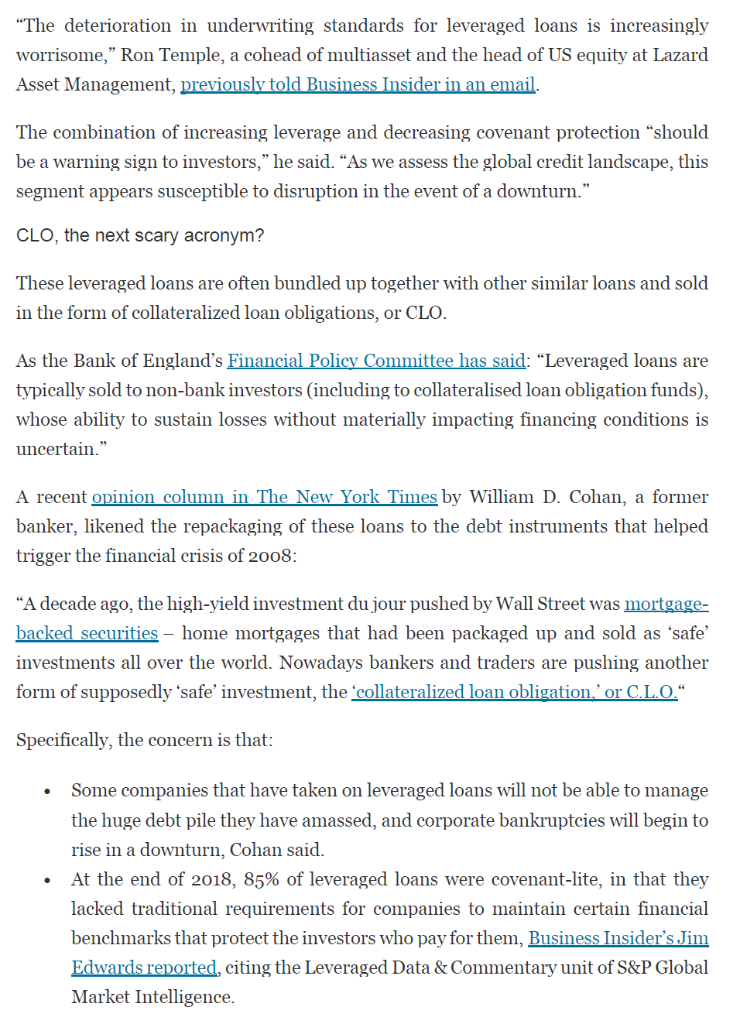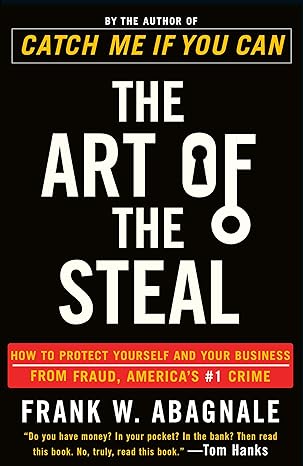According to the article titled A $1.6 trillion credit market could batter the global economy. And you will take the hit if it implodes, not Wall Street by Callum Burroughs answer the following questions:
Why was securitisation considered as one of the main causes at the heart of the global financial crisis in 2007? (about 200 words)
From the point of view of regulators, say in the United States, what could be done? And what do you think will be done about it? (about 200 words)



A $1.6 trillion credit market could batter the global economy. And you will take the hit if it implodes, not Wall Street CALLUM BURROUGHS MAR 23, 2019, 1:11 AM Leveraged loans make up an approximately $US1.6 trillion market, and a variety of financial experts have raised concerns about the booming industry. These loans are typically packaged into complex credit instruments that are then purchased by pension funds and mutual funds, among others The market has been criticised for the weak protections afforded to investors, with some fears that it could lead to major issues in the event of an economic downturn or recession. These are, in simple terms, loans to riskier companies that have amassed a large amount of debt relative to their earnings. And the market for these loans has boomed Amid an extended period of low interest rates, 2017 saw a record amount of leveraged loan issuance, and 2018 followed close behind, with over $US700 billion in total issuance. The total of outstanding loans is estimated to be between $US1.4 trillion and $US1.6 trillion A vast swathe of companiesncluding SpaceX, Uber, and Tesla, have taken advantage of beneficial lending conditions of late to pile up large amounts of debt that often come with loose legal requirements - known as covenant-lite - providing lenders witlh limited protections And as the market has grown, the warnings have gotten louder. The Federal Reserve and the Bank of England have both expressed concern about the market, while the Financial Stability Board said it would investigate the growing industry "The deterioration in underwriting standards for leveraged loans is increasingly worrisome," Ron Temple, a cohead of multiasset and the head of US equity at Lazard Asset Management, The combination of increasing leverage and decreasing covenant protection "should be a warning sign to investors," he said. "As we assess the global credit landscape, this segment appears susceptible to disruption in the event of a downturn." CLO, the next scary acronym? These leveraged loans are often bundled up together with other similar loans and sold in the form of collateralized loan obligations, or CLO As the Bank of England's Financial Policy Committee has said: "Leveraged loans are typically sold to non-bank investors (including to collateralised loan obligation funds), whose ability to sustain losses without materially impacting financing conditions is uncertain A recent opinion column in The New York Times by William D. Cohan, a former banker, likened the repackaging of these loans to the debt instruments that helped trigger the financial crisis of 2008 A decade ago, the high-yield investment du jour pushed by Wall Street was mortgage- backed securities home mortgages that had been packaged up and sold as 'safe' investments all over the world. Nowadays bankers and traders are pushing another form of supposedly 'safe investment, thecollateralized loan obligation. or CLO Specifically, the concern is that Some companies that have taken on leveraged loans will not be able to manage the huge debt pile they have amassed, and corporate bankruptcies will begin to rise in a downturn, Cohan said. . At the end of 2018, 85% of leveraged loans were covenant-lite, in that they lacked traditional requirements for companies to maintain certain financial benchmarks that protect the investors who pay for them, Business Insider's Jim Edwards reported, citing the Leveraged Data & Commentary unit of S&P Global Market Intelligence . If corporate bankruptcies rise, then weaker lender protections that go with covenant-lite deals will see the ultimate owners of the debt struggle to recover their investments, hurting returns Fed Chairman Jerome Powell has said he expects that investors in CLOs are likely to bear the brunt of corporate bankruptcies, Cohan said, while JPMorgan Chase CEO Jamie Dimon has said Wall Street banks aren't that exposed to the market . "For now, my view is that such losses are unlikely to pose a threat to the safety and soundness of the institutions at the core of the system, and instead, are likely to fall on investors," Powell said late last year, according to Bloomberg Business Insider's Dakin Campbell described Dimon as saying that the largest banks "tend to invest in the safest part of the market, a category that accounts for about half of all outstanding leveraged loans." . So who are the investors in CLOs? Think hedge funds, mutual funds, and pension funds, Cohan said - "in other words, you and me." The market could continue to arow The leveraged-loan market is only a major issue in the event of companies running into economic difficulties. And the market could continue to grow for some time. Views about a US recession vary, but generally signals point to a downturn by 2020 The other issue to consider is the broader economic context for the rise of leveraged loans. The limited appeal of US Treasuries and other government bonds has led to investors seeking better returns from other parts of the market. This seems unlikely to change, giventhe Fed'sdecision_onWednesday to not increase interest rates, indicating it would keep them static for the rest of 2019 Recent figures indicate the leveraged-loan market was heating up in February, With issuance standing at $US61.2 billion, up 50% from January but down from February 2018,according to data from Reuters LPC cited by ABL Advisor CLO issuance in the US stood at $US13 billion in February, according to data from LCD A $1.6 trillion credit market could batter the global economy. And you will take the hit if it implodes, not Wall Street CALLUM BURROUGHS MAR 23, 2019, 1:11 AM Leveraged loans make up an approximately $US1.6 trillion market, and a variety of financial experts have raised concerns about the booming industry. These loans are typically packaged into complex credit instruments that are then purchased by pension funds and mutual funds, among others The market has been criticised for the weak protections afforded to investors, with some fears that it could lead to major issues in the event of an economic downturn or recession. These are, in simple terms, loans to riskier companies that have amassed a large amount of debt relative to their earnings. And the market for these loans has boomed Amid an extended period of low interest rates, 2017 saw a record amount of leveraged loan issuance, and 2018 followed close behind, with over $US700 billion in total issuance. The total of outstanding loans is estimated to be between $US1.4 trillion and $US1.6 trillion A vast swathe of companiesncluding SpaceX, Uber, and Tesla, have taken advantage of beneficial lending conditions of late to pile up large amounts of debt that often come with loose legal requirements - known as covenant-lite - providing lenders witlh limited protections And as the market has grown, the warnings have gotten louder. The Federal Reserve and the Bank of England have both expressed concern about the market, while the Financial Stability Board said it would investigate the growing industry "The deterioration in underwriting standards for leveraged loans is increasingly worrisome," Ron Temple, a cohead of multiasset and the head of US equity at Lazard Asset Management, The combination of increasing leverage and decreasing covenant protection "should be a warning sign to investors," he said. "As we assess the global credit landscape, this segment appears susceptible to disruption in the event of a downturn." CLO, the next scary acronym? These leveraged loans are often bundled up together with other similar loans and sold in the form of collateralized loan obligations, or CLO As the Bank of England's Financial Policy Committee has said: "Leveraged loans are typically sold to non-bank investors (including to collateralised loan obligation funds), whose ability to sustain losses without materially impacting financing conditions is uncertain A recent opinion column in The New York Times by William D. Cohan, a former banker, likened the repackaging of these loans to the debt instruments that helped trigger the financial crisis of 2008 A decade ago, the high-yield investment du jour pushed by Wall Street was mortgage- backed securities home mortgages that had been packaged up and sold as 'safe' investments all over the world. Nowadays bankers and traders are pushing another form of supposedly 'safe investment, thecollateralized loan obligation. or CLO Specifically, the concern is that Some companies that have taken on leveraged loans will not be able to manage the huge debt pile they have amassed, and corporate bankruptcies will begin to rise in a downturn, Cohan said. . At the end of 2018, 85% of leveraged loans were covenant-lite, in that they lacked traditional requirements for companies to maintain certain financial benchmarks that protect the investors who pay for them, Business Insider's Jim Edwards reported, citing the Leveraged Data & Commentary unit of S&P Global Market Intelligence . If corporate bankruptcies rise, then weaker lender protections that go with covenant-lite deals will see the ultimate owners of the debt struggle to recover their investments, hurting returns Fed Chairman Jerome Powell has said he expects that investors in CLOs are likely to bear the brunt of corporate bankruptcies, Cohan said, while JPMorgan Chase CEO Jamie Dimon has said Wall Street banks aren't that exposed to the market . "For now, my view is that such losses are unlikely to pose a threat to the safety and soundness of the institutions at the core of the system, and instead, are likely to fall on investors," Powell said late last year, according to Bloomberg Business Insider's Dakin Campbell described Dimon as saying that the largest banks "tend to invest in the safest part of the market, a category that accounts for about half of all outstanding leveraged loans." . So who are the investors in CLOs? Think hedge funds, mutual funds, and pension funds, Cohan said - "in other words, you and me." The market could continue to arow The leveraged-loan market is only a major issue in the event of companies running into economic difficulties. And the market could continue to grow for some time. Views about a US recession vary, but generally signals point to a downturn by 2020 The other issue to consider is the broader economic context for the rise of leveraged loans. The limited appeal of US Treasuries and other government bonds has led to investors seeking better returns from other parts of the market. This seems unlikely to change, giventhe Fed'sdecision_onWednesday to not increase interest rates, indicating it would keep them static for the rest of 2019 Recent figures indicate the leveraged-loan market was heating up in February, With issuance standing at $US61.2 billion, up 50% from January but down from February 2018,according to data from Reuters LPC cited by ABL Advisor CLO issuance in the US stood at $US13 billion in February, according to data from LCD









